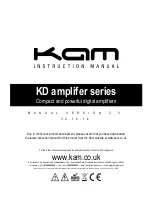
2
800.828.8184
www.headphone.com
1.
The Headphone Jack.
This is a 1/4” headphone jack. Adaptors for
1/8” jacks are available, as well as splitters to run more than one pair of headphones.
2.
The Volume Control.
We recommend turning the amp OFF or ALL THE
WAY DOWN before plugging in or unplugging your headphones to avoid short-
circuiting the amp.
As you turn the volume control knob clockwise, the volume
increases. If you’re switching between two or three pairs of headphones with
different input impedance ratings, different volume settings will most likely be
necessary to achieve similar sound levels.
3.
The
LED’s.
Immediately to the right of the volume control knob are two green
LEDs. These simply tell you that the unit is on and working. We made them intensely
bright so that you can also cut through two inches of steel with them, blind an
attacker, or summon the mothership from the opposite end of the solar system.
Pretty handy, huh?
4.
The Processor Switch.
This switch engages and disengages the headphone
audio image processing circuit. Headphone audio imaging is not very good; typically
the image is a blob on the left, a blob on the right, and a blob in the middle. The
HeadRoom audio image processor provides the natural acoustic cross-feed normally
heard from the left speaker to the right ear, and from the right speaker to the left
ear. Adding the cross-feed signal gives your brain enough information to build up
the stable and natural audio image needed to have a quality listening experience.
5.
The Filter Switch.
The filter switch is used to compensate for the warming
action of the processor. In the center position there is no filter in the circuit; generally
this is preferred. But if the processor is causing too much bass or blurring of the
central image, a mild high frequence boost filter can be turned on. The “bright”
setting accentuates the highs at about 3 kHz; with the “brighter” setting the filter
starts an octave earlier and catches some of the upper mids. Basically, set it to what
ever sounds best to you.
You may be wondering by now why you haven’t been able to find the power
switch. Well, limited real estate on the circuit board forced its elimination. (It
was either that or the headphone jack.) But it’s easy to live without it. Just
plug the amp in and you’re ready to listen. You should
unplug the headphones
or turn the volume down all the way
when plugging or unplugging the amp to
avoid smoking them with a surge of electric current. Leaving the amp plugged
in all the time is not a problem.
A Tour of Your Little HeadRoom


























